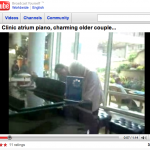Last week, I got a direct-message tweet from Amber Smith (@AmberSmith), a reporter from Syracuse, NY. I had met Amber previously (because of Twitter) and we have interacted via Twitter, and she was tweeting because she had seen some chatter about one of our Mayo Clinic videos being among the most-tweeted videos on Twitter. It’s about continuous chest compressions, a kind of CPR that doesn’t involve mouth-to-mouth.
I have embedded that video below, but here’s the link to the in-depth story Amber did for Syracuse.com, as well as the sidebar about the viral phenomenon with this video (most of the nearly 3 million combined views as of this moment have been from a copy the Arizona Department of Health Services uploaded) and a post with more links to relevant research papers on Amber’s personal blog.
This story is another example of both Thesis 9 and Thesis 33. The original video was produced as part of our Mayo Clinic Medical Edge news program for television stations, and the story ran in 2008. Now, because of the power of social media, it has gone viral, which has led to more mainstream news coverage, which will undoubtedly increase the YouTube traffic. And as a result, more people who are untrained in mouth-to-mouth CPR will be aware of the continuous chest compressions alternative.
I hope you will take a couple of minutes to watch the video above, and also to read Amber’s story. Then I hope you will share this post (or the video) with your friends via email, or Facebook, or Twitter, or however you like to spread the word.
